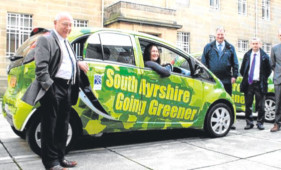
A multi-million pound fleet of eco-friendly council cars, bought with taxpayers’ cash, are lying barely used.
The majority of electric vehicles snapped-up by council chiefs as part of a plan to help the environment fail to clock 10 miles a day with some averaging little over two.
That’s despite local authorities splurging at least £2.8 million on 140 of the emission-free cars.
Eben Wilson, of Taxpayer Scotland, branded the cash layout pointless. He said: “Spending hard-working families’ taxes deserved honesty and transparency. These numbers show that contribution of these cars to productivity is minuscule in essence most of the spending has been unnecessary and largely wasted.”
The Scottish Government through Transport Scotland urged councils to invest in the vehicles by offering generous grants. They hoped to help reduce the country’s carbon footprint. Those included the Low Carbon Vehicle Procurement Support Scheme, launched by First Minister Alex Salmond in 2010.
That initiative made £3.6 million available to councils to buy or lease eco-friendly cars. But we discovered that many of the 140 vehicles picked up by councils under the schemes spend most of their time gathering dust.
South Ayrshire Council bought four Peugeot iONs for £87,000 in 2012. Our probe found that those cars travel an average of just 27 miles a week, with one car driving a mere 1,590 miles in two years roughly two miles a day.
In South Lanarkshire, 16 iONs were bought for use by council staff for £322,000 in 2011 and 2013. Several of those tally between just four and five miles a day.
And in Perth and Kinross where council funds and Transport Scotland grants procured four Nissan leafs for a total £106,000 in March 2012 the cars average fewer than seven miles each day.
Tory transport spokesman Alex Johnstone said: “Research into new transport technology must be encouraged. But politically correct pursuits of electric cars, when there is no substantial evidence that suggests they will provide a long-term solution is a waste of resources. The cost of building and then running this type of car is hard to justify when they’re only travelling such tiny distances.”
Aberdeen City Council have only one electric car an £11,000 Mitsubishi i-Miev bought with the help of a Scottish Government grant in 2013. It covers a modest 12.5 miles a day.
Dundee City Council have been by far the biggest investors in eco-cars, using £628,000 of taxpayers money to procure 37 since 2012. Council bosses claim that last year the cars completed 250,000 miles, the equivalent of each travelling 18 miles a day.
But in Glasgow where the council is in talks to extend their fleet estimates suggest as much as £500,000 has been spent on Nissan Leafs and Peugeot Partner cars, the average of which completes a daily route of only seven miles.
Mr Wilson added: “It’s time for a complete re-think about using our taxes for these so-called climate change mitigation schemes.”
A Transport Scotland spokesperson said: “The day to day operation of council fleet vehicles is a matter for individual councils.”

Enjoy the convenience of having The Sunday Post delivered as a digital ePaper straight to your smartphone, tablet or computer.
Subscribe for only £5.49 a month and enjoy all the benefits of the printed paper as a digital replica.
Subscribe